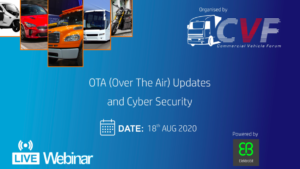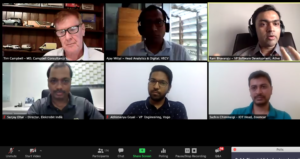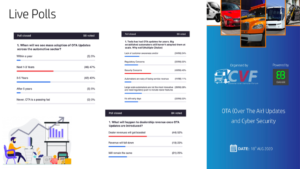Over the Air (OTA) updates and Cyber Security

“OTA and imperative while managing challenges such as security and technical ability”
On 18th August, Commercial Vehicle Forum (CVF) team conducted a live panel discussion on advanced and critical subject titled “Over the Air updates and Cyber Security” from 1100hrs – 1200 hrs. The webinar had a total registration of over 500 attendees with a comprehensive mix of individuals across dealers, technology specialists from OEMs and senior leaders from Logistics Service Providers.
The webinar included noted speakers such as Mr. Nikunj Sanghi, President ASDC – Director FADA; Mr Ajay Mittal – Head of Analytics and Digital, VECV; Mr Sachin Chimmalgi – IOT Head – Zoom Car; Mr Abhimanyu Goyal, VP Engineering, Vogo Automobile Pvt Limited; Mr Sanjay Dhar, Director, Elektrobit India; Mr. Ram Bhavaraju – Head Software & Web Technologies, Ather; Ms. Pavithra Kumaraswamy, Lead Technical Analyst, Elektrobit India

Speaking to the panellists, Mr. Tim Campbell, Managing Director, Campbell Consulting, started discussion with what impact is COVID having on the software industry and the unprecedented times auto industry is facing? To this speakers were in agreement that in times such as these connected vehicle has played a huge role in identifying the challenges vehicles are facing. Technology has the ability to pin point the pain areas. Further, speaker added push for software driven approach has received a big thrust in times such as these. Also, another aspect is the ability of technology to improve the product quality to enhance customer experience.
Mr Ajay Mittal from VECV mentioned that at Volvo they have introduced a new concept called uptime which is a software platform offering ability to the buyers of BSVI vehicles to take preventive steps in case of any challenge is expected in the vehicle in the coming time. This is also enables VECV to continuously improve its product quality. He further added that one of the learnings of COVID is that vehicles need to work with OTA updates even though its in early stage but that’s the future. He added that journey for OTA and connected has to go together.
Mr. Tim Campbell threw light on the aspect that sometimes network connectivity tends to be a problem. Does it mean that network holds back some of the potential that the software has? To this Mr. Abhimanyu from Vogo responded that in their company everything is driven by 2G and 4G network. However, in the past there have been instances that software update has failed due to network issues and that’s the reason Bluetooth technology has also come to forefront. In the cases where vehicles are sometimes parked in multiple numbers next to each other Bluetooth technology comes in very handy.
Audience also participated through the poll questions and one of the area which was stressed upon was if regulators drive the adoption it will move forward quickly as in the case of BSVI and tonnage norms. Further security concerns came out to be another critical aspect that audience reflected upon.
To address the topic of security via OTA, Mr. Tim Campbell drew feedback from Ajay Mittal from VECV. He shared that the way to manage security concern is to break this into two aspects – “Local OTA” and “Remote OTA”. Volvo has created a device at its dealership where OTA is conducted through Bluetooth and it takes care of the security concerns. Another aspect is Remote OTA – in that case technical ability of the technician also needs to be considered. If call for repair has come from 100 Kms away then dealer’s technician needs to evaluate whether OTA is required and if problem is from the software side.
Further Mr Sanjay from Elekrtobit added that any vehicle whether car/truck or two wheeler these days is as good as any device on internet which is susceptible to security threats. He mentioned that security needs to be considered as one of the core aspects while connecting the vehicle. In most of the cases platform is built and then security is built over the top. He recommended that at the time of foundation itself security needs to be built into the software to make the communication channels secure.
Mr. Nikunj Sanghi, Director FADA added that dealership is the area where OTAs can happen in extremely secure environment. Customers in India are not particularly aware of security aspects so dealership is the area where SOPs can be followed, car can be tested; which could also mean additional revenue for dealership. Another way to look at this is that most of the challenges in OTA come in software and not in hardware. These software challenges also offer opportunity to dealerships.
Further Mr. Campbell asked – in the case where there are 2 – 3 manufacturer of the hardware how to ensure that software updates work seamlessly across manufacturers? To this Mr. Abhimanyu added that the core of the design of the software and hardware has to be thought through. It has to be thought through ground up so that different products can be integrated into the fleet. Mr. Sachin further added that when OEM looks at this they work with multiple vendors and at their end it is not possible to develop plug and play system. From OEMs perspective different ECUs have to be handled with a perspective that they have to be integrated at some stage. ECUs are the way to go with interface built around it. Further, Mr. Sanjay added that OTA has two components backend and front end. Backend component can remain constant across the vehicles and platforms. On the device side i.e. vehicle differences need to be adopted.
Mr. Ajay from Volvo mentioned that layer of abstraction happens at ECU level and connectivity happens at telematics side. Telematics is the gateway which enables any activity on the device. Security becomes critical in this aspect as communication needs to be secure. As industry proceeds further it is going to become easier to implement, market readiness, network everything would evolve.

Poll questions were also run among the audience such as what will derive the mass adoption of OTA? How long would it take for OTA to become a norm given current speed of adoption? Polls during the discussion made the discussion interactive and enables moderator to gather the view of audience at large.
The session ended with an interactive Q&A session between attendees and speakers wherein a total 40 questions were asked. While the speakers couldn’t answer all the queries given the paucity of time, they were able to address majority of the concerns of the audience If you want to be part of our next webinar, please get in touch with Mr. Raghav Shankar on +91 9599881027 or email him on raghav@threefold.in